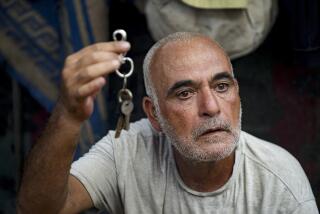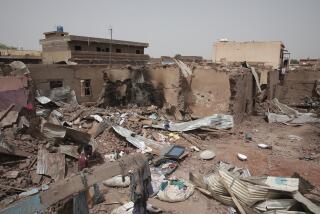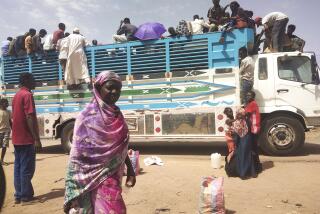Regional Outlook : No Relief for Africa’s Troubled Horn : Cursed by man and nature, the region hosts three of the continent’s seven civil wars. Famine, poverty and repression add to the misery.
ADDIS ABABA, Ethiopia — The haul of weapons this country’s new rulers collected from its former government officials last month was impressive in its diversity.
The guns lay in a pile at the collecting station, where a youthful rebel soldier, now part of a regular army, issued receipts: Soviet-made carbines and AK-47 automatic rifles predominated, but there were also Belgian rifles, Israeli Uzis and even a lonely American Winchester.
The pile of armaments is an emblem of one of the great problems of the region known as the Horn of Africa. Collectively, Ethiopia, Sudan, Somalia and Djibouti constitute one of the most heavily militarized corners of the world.
It is also one of the most cursed, by man and nature.
The Horn hosts three of Africa’s seven civil wars and a area wide famine--possibly the worst since the Ethiopian disaster of 1984-85--afflicting nearly 20 million people. There has not been a peaceful change of government in more than 25 years (with the exception of some political maneuvers in Djibouti, which gained its independence from France in 1977).
The longstanding former leaders of Ethiopia and Somalia, Mengistu Haile Mariam and Mohamed Siad Barre, both left their domains at gunpoint in recent months: Mengistu taking flight in a small plane and heading for exile in Zimbabwe; Siad Barre leaving his palace in a tank and holing up in his home district in an isolated corner of southern Somalia.
All four countries of the Horn rank among the 42 classified by the United Nations as Least Developed Nations; Ethiopia holds the unfortunate distinction of being one of the world’s poorest nations based on per capita income.
War, famine, poverty, repression--the Horn of Africa is, in the words of a Western diplomat who recently served in Ethiopia, “a theme park for the Four Horsemen of the Apocalypse.”
Moreover, there is no guarantee that the recent revolutions in Somalia and Ethiopia will make things any better--at least, not anytime soon. And as always, the greatest toll is among the innocent.
The final collapse in January of Siad Barre’s Somali government came as troops representing a number of rebel groups entered the capital, Mogadishu, and laid waste to what was left of public order.
Since then, Somalia has been so chaotic--seven clan-based insurgent groups are still fighting each other--that the United Nations and private relief agencies dare not re-enter the country to restore relief programs for its 8.4 million people. Last month, the Somali National Movement, a rebel group, declared the independence of northern Somalia, marking the first African secession since the bloody episode of Biafra in 1969.
In Ethiopia, Mengistu sat out the endgame of two civil wars, one lasting 30 years and the other 16, then fled too late, leaving a government and army in collapse and a capital undefended against a rebel assault.
That was followed by a second breakaway--that of the province of Eritrea from the rest of Ethiopia. The newly victorious Eritrean People’s Liberation Front says it will submit the question of Eritrea’s independence to a public, internationally supervised referendum, but for now the province is functioning as a sovereign state in all but name.
Whether the region’s relief needs--estimated at more than a million tons each this year for Ethiopia and Sudan alone--will decline depends on more than the wars’ end. Ethiopia needs new, non-socialist agricultural policies to realize its considerable, and overlooked, potential.
Meanwhile, the final burst of fighting in Ethiopia and Somalia sent hundreds of thousands of new refugees over their borders into neighboring countries. Djibouti, a tiny entrepot on the Red Sea once known as French Somaliland, might have been spared the worst of the regional plight except for the overflow from its neighbors: It now has close to 100,000 refugees from the Somali and Ethiopian civil wars within its borders, at least 30,000 of whom have arrived in the last month.
Many other fleeing Somalis had nowhere to go but Ethiopia, where they have fallen prey to bandits and drought. Relief officials believe the end of the Ethiopian conflict will make it easier to move emergency food into the country--but the breakdown of security in the rural areas where the grain must end up has created a surge in brigandage.
Among the targets of bandits and hostile insurgents was the population of 300,000 Sudanese refugees encamped around the western Ethiopian town of Gambela, including as many as 100,000 orphaned boys below the age of 16. Staff of the Office of U.N. High Commissioner for Refugees, which ran the camps, had already pulled out, and the camps had not had deliveries of food in nearly a month.
Reports suggest that all 300,000 are on the move again, this time back into southern Sudan, where there is little to eat but grass and stalks. And they are again at the mercy of the Arab militias that drove them out of their homes years ago.
To the east, the evaporation of the Somali state menaces more than 600,000 people in the Ogaden, the border region where Ethiopia and Somalia meet. That includes 80,000 Ethiopians who were just returning home from refugee camps in Somalia and are now caught between drought and civil strife. Relief officials say the problem in the Ogaden is at a crisis stage because a lack of security prevents them from bringing in emergency food.
To a very great extent the experience of the countries of the Horn confounds the received wisdom about the sources of Africa’s troubles.
Those who ascribe the continent’s problems to its colonial history, for example, must confront the fact that parts of the Horn are among the most lightly colonized regions of sub-Saharan Africa.
With the exception of Eritrea, its northernmost province, Ethiopia was never colonized (although its capital was briefly occupied by Italy). Part of Somalia was held as a protectorate by Britain and another part by Italy, but it has remained perhaps the most ethnically coherent place in Africa.
And Sudan, while governed for many years by a British-Egyptian “condominium,” was still administered by a class with traditional claims to leadership through their descent from leading Muslim clans.
“Despite what people say about artificial colonial borders and so on,” says Christopher Clapham, an expert in Horn politics at Lancaster University in England, “these governments are, in a real sense, indigenous.”
But Clapham argues that, paradoxically, the very thin veneer of colonialism ended up exacerbating class and clan differences and animosities.
“When you have a ruling group, non-colonial based,” he says, “the inequalities become more evident than when everyone is a subject of colonialism together.”
Even without colonialism--usually blamed in Africa for the predominance of geographically nonsensical and unworkable political boundaries--the countries of the Horn managed to resolve themselves into unstable entities. The union of Eritrea and Ethiopia was a dream of Emperor Haile Selassie, who persuaded the young United Nations to recognize greater Ethiopia as a federation in 1952.
The union was made formally complete in 1962, by which time the imperial government’s insensitive and arrogant treatment of the “federated” Eritreans had already provoked the creation of secessionist insurgent groups and the start of a 30-year civil war.
Somalia’s instability was similarly homemade, by the union in 1960 of newly independent British Somalia, in the north, with the former Italian Somalia. “It was a hasty decision,” says Ioan Lewis, an anthropologist at the London School of Economics specializing in the Horn, “and the northern Somalis have been regretting it ever since.”
By some standards, says Lewis, the recent breakup of Ethiopia and Somalia may be all to the good.
“They couldn’t be any less stable” than the pre-existing federations, he notes; the new northern Somalia will at least be more homogeneous by clan (Issaks predominate) than was the old country. In any event, the countries of the region are bound together by economic interest.
But these recent events still beg the question of why the Horn has been such a magnet for misery.
Perhaps one thread binding these countries together is sheer bad luck. When government is a series of autocracies and political pluralism an alien concept, then the quality of a nation’s leadership is very much a matter of chance.
A few African countries have been fortunate in this respect, getting relatively visionary, intelligent and responsive leaders, such as Ivory Coast’s Felix Houphouet-Boigny or Zimbabwe’s Robert Mugabe. But statesmen of that caliber have been thin on the ground in the Horn of Africa, and the trend has been negative.
When the nominally democratic Sudanese government of Sadek Mahdi was overthrown by a military coup in 1989, for example, it went unlamented. Mahdi had pursued a ruinous civil war with rebels in the south, resisting all efforts at a political solution, and was trying to impose Islamic sharia law on his partially Christian and animist country. The new government could scarcely be worse, many reasoned.
They were wrong. The government of Lt. Gen. Omar Hassan Ahmed Bashir (himself probably a figurehead for the National Islamic Front, led by Hassan Turabi, foreign minister under Mahdi) has gone ahead with sharia and redoubled the vigor of the southern war. Thrown into the bargain is its extreme xenophobia and its harassment of aid organizations and foreign donors trying to relieve a famine that has 7 million rural Sudanese at its mercy.
Somalia’s leadership also chose a particularly destructive method of retaining power: Rather than harnessing the country’s ethnic unity in the service of nationhood, Siad Barre after seizing power in 1969 pursued a divide-and-conquer strategy based on the genealogical differences among the country’s clans.
“By stirring up clan consciousness Siad Barre shook the state apart,” says Lewis. Ironically, Mengistu’s manipulation of Ethiopian nationalism also aggravated ethnic tensions. The notion of Ethiopian unity had long been associated with rule by the Amhara ethnic group, and Amhara domination made the rest of Ethiopia ethnically conscious, says Lewis. Insofar as Ethiopia was really a mosaic of ethnic Amhara, Oromo, Tigreans, Afar, Eritreans, and others, the product was a country difficult to govern and one in which ethnic insurgencies proved impossible to stop.
Mengistu’s maneuvering on religious issues underscores another historical burden of the Horn countries, particularly Ethiopia and Sudan: their geographical location at the border of Muslim and Christian Africa.
Part of the Eritrean secessionists’ appeal was based on that province’s greater Muslim character compared with the rest of Ethiopia, which is largely Christian Orthodox. In his turn, Mengistu often stirred up support for his military (which consumed 60% or more of the poverty-stricken country’s budget) by deriding the Eritrean rebels as “Arabs.”
The Muslim-Christian split is also a key rift within the Sudanese state, particularly as it parallels the ethnic and geographic division between Arab north and black African south.
Its geographical location at the edge of the Middle East may account for another burden of the Horn: its Soviet- and American-equipped armories. Beginning in the 1960s, Somalia and Ethiopia became an important ideological battleground of the two superpowers. This condition persisted until the late 1980s, when Mikhail S. Gorbachev reined in the Soviet Union’s adventuresome streak and thus “devalued the real estate” of the Horn, in the words of an experienced Western diplomat.
But the two-decade long, superpower-sponsored arms race in the region continues to reverberate today. “The sheer level of armaments is very significant,” says Clapham, noting that it is impossible to restrict the movement of weaponry into private hands and throughout the region. “These arms get transferred all over.”
The arms, however, are only the tools of the Horn’s deeper maladies. “It’s a terrible commentary,” says one Western expert on the region, “on bad government and bad management.”
More to Read
Sign up for Essential California
The most important California stories and recommendations in your inbox every morning.
You may occasionally receive promotional content from the Los Angeles Times.









